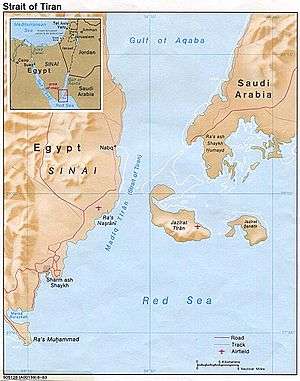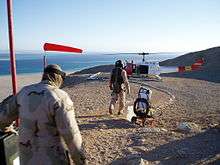Tiran Island
| Disputed island Other names: Yotvat (Hebrew) | |
|---|---|
 | |
| Map of Tiran and Sanafir Islands | |
| Geography | |
| Location | Red Sea |
| Coordinates | 27°57′N 34°33′E / 27.950°N 34.550°ECoordinates: 27°57′N 34°33′E / 27.950°N 34.550°E |
| Total islands | 1 |
| Area | 80 square kilometres (31 sq mi) |
| Administered by | |
| Egypt | |
| Claimed by | |
| Saudi Arabia | |
| Demographics | |
| Population | Uninhabited |


Tiran (Arabic: جزيرة تيران Jazīrat Tīrān,[1] aka Jezîret Tīrān[2] Egyptian Arabic: [ɡæˈziːɾɪt tɪˈɾæːn] and Yotvat Island,[3][4] is an island[5] that is administered by Egypt. The island is located at the entrance of the Straits of Tiran, which connects the Red Sea to the Gulf of Aqaba. It has an area of about 80 square kilometres (31 square miles). It is part of the Ras Muhammad National Park. The Straits of Tiran is Israel's only access from the Gulf of Aqaba to the Red Sea, and Egypt's blockade of the Straits of Tiran on 22 May 1967 was the casus belli for Israel in the Six Day War.[6]
Tiran Island is of strategic significance in the area, as it forms the narrowest section of the Straits of Tiran, which is an important sea passage to the major ports of Aqaba in Jordan and Eilat in Israel. Israel briefly took over Tiran Island during the Suez Crisis and again from 1967 to 1982 following the Six Day War. The island is inhabited only by military personnel from Egypt and the Multinational Force and Observers (MFO).
Chisholm Point is a cape of Tiran Island.
Some sources report that many beaches on the island are mined.[7]
On 9 April 2016, the Egyptian government declared that Tiran and Sanafir Island fall within the territorial waters of Saudi Arabia, as codified in the maritime border agreement signed with the government of Saudi Arabia on the previous day.[8] The agreement needs to be ratified by Egypt's Parliament,[8][9] and has reportedly been quashed by an Egyptian judge.[10]
Ancient history - Iotabe
Tiran may be the island that Procopius called Iotabe (in Greek Ἰωτάβη), which was an important toll station for shipping in the area, but other islands in the Gulf of Aqaba have been proposed as alternative identifications. In 473 a Saracen named Amorkesos captured the island and appropriated the revenues, but the Byzantine Empire retook it 25 years later, granting its inhabitants autonomy, subject to payment of taxes on goods exported to India. Around 534, the Byzantines had to retake it again from a group whom Choricius of Gaza called an unholy race, and whom some scholars suppose to have been the Jewish inhabitants who had refused to pay the taxes.[11][12][13]
The earliest and latest dates mentioned in relation to Iotabe are given in relation to the participation of bishops of the island in the church councils: Macarius in the Council of Chalcedon in 451 (in whose acts the diocese is listed as belonging to the Roman province of Palaestina Tertia), and Anastasius in a synod held at Jerusalem in 536.[11][14]
There is no mention of Iotape in accounts of the Islamic conquests, suggesting that by then the island was uninhabited.[11]
Since it is no longer a residential bishopric, Iotape, in its Latin form called Iotapa in Palaestina, is today listed by the Catholic Church as a titular see.[15]
The reference by Procopius to an autonomous Jewish community on the island of Iotabe until the 6th century figured in Israeli rhetoric during the Suez crisis and during and immediately after the Six Day War.[16]
Modern history
"Egypt and Saudi Arabia clarified their sovereignty claims to the islands in 1954, when Egypt informed the UN Security Council that the two islands had been Egyptian territory since the delimitation of the frontier between Egypt and the Ottoman Empire in 1906."[17]
However, according to the Ministry of Foreign Affairs of Israel the islands hadn't belonged to Egypt before 1949.[18]
During World War II, the Egyptian forces on Tiran and Sinafir islands were part of the Egyptian troops protecting Suez canal, according to Egypt's representative at the 659th UN security council meeting on 15 February 1954.[19] In the same meeting, Egypt's representative considered Tiran and Sinafir islands an integral part of the territory of Egypt since they have been under Egypt's administration since 1906.[20]
In March 1949, Israeli forces took control of the area around the coastal village of Umm al-Rashrash, later renamed Eilat, as part of Operation Uvda. The uninhabited islands of Tiran and Sanafir gained strategic importance since they controlled all shipping to Eilat, Israel's only access to the Red Sea. In May 1948, Egypt blocked passage through the Suez Canal to Israeli-registered ships and to ships (Israeli or otherwise) carrying cargo to and from all Israeli ports. Since all land trade routes were blocked by other Arab states, Israel's ability to trade with East Africa and Asia, mainly to import oil from the Persian Gulf, was severely hampered.[18]
In December 1949 Egypt started to erect military installations on Tiran, Sanafir and the Sinai coast opposite the islands to control the straits.[21] Soon after, the Egyptian Government officially denied an intention to interfere with peaceful navigation,[22] communicating its accord with Saudi Arabia to UK and US on 30 January and 28 February 1950 respectively:[23]
Taking into consideration certain velleities which have manifested themselves recently on the part of Israel authorities on behalf of the Islands of Tiran and Sanafir in the Red Sea at the entrance of the Gulf of Aqaba, the Government of Egypt acting in full accord with the Government of Saudi Arabia has given orders to occupy effectively these two islands. This occupation is now an accomplished fact.
In the same accord, Egypt claimed its right to the islands as well as possible right for the Kingdom of Saudi Arabia:[23]
In doing this Egypt wanted simply to confirm its right (as well as every possible right of Kingdom of Saudi Arabia) in regard to the mentioned islands which by their geographical position are at least 3 marine miles off the Egyptian side of Sinai and 4 miles approximately off the opposite side of Saudi Arabia, all this in order to forestall any attempt on or possible violation of its rights.
As Saudi media explained in 2016, Saudi king Abdel Aziz al-Saud granted Egypt permission to defend the islands since he was afraid of possible Israeli expansion while his kingdom lacked a suitable naval force to protect them.[24]
According to a 2016 statement by the Egyptian Cabinet Information and Decision Support Center, the Egyptian chief delegate to the UN denied any territorial claims on the islands in May 1967, after the then Egyptian president Gamal Abd al-Nasser closed the Straits of Tiran to Israeli shipping (which was considered as a casus belli by Israel to initiate the Six Day War): "Egypt did not seek at any time to claim that the sovereignty of the two islands has been transferred to it. Rather Egypt only sought to take over defending the two islands."[25] Shortly thereafter Tiran Island was captured by Israeli Defense Forces troops during the Six Day War.[26] In January 1968, the US government stood behind a failed attempt to induce Israeli withdrawal from that island as an opening move to a larger peace process.[27]
Tiran remained under Israeli control until its return to Egypt in 1982 in fulfilment of the 1979 peace treaty signed by Egypt and Israel. The treaty includes a guarantee of freedom of Israeli shipping through the Straits of Tiran.[28]
The agreement by Egypt to return the islands of Tiran and Sanafir to Saudi Arabia required the approval of Israel to modify the military annex to the peace treaty. Israel was notified in writing about the transfer weeks before it was made public, and gave its approval in writing to Egypt and, indirectly, to Saudi Arabia. Saudi Foreign Minister Adel al-Jubeir publicly stated that his country would honor the Israel-Egypt peace treaty’s terms as regards the island and the continued stationing of the Multinational Force and Observers (MFO) forces on the island. Israel also agreed to the construction of the Saudi-Egypt Causeway between the Egyptian and Saudi mainlands which would pass through Tiran.[29][30]
Transport
The planned Saudi-Egypt Causeway would pass through Tiran Island.
See also
Notes
- ↑ "Jazīrat Tīrān: Egypt". Geographical Names. Retrieved 2011-03-04.
- ↑ "Jezîret Tīrān: Israel". Geographical Names. Retrieved 2011-03-04.
- ↑ "Yotvat Island: Egypt". Geographical Names. Retrieved 2011-03-04.
- ↑ Shindler, Colin (2013). A History of Modern Israel (1st ed.). Cambridge University Press. p. 122. ISBN 978-1-10702862-3. Retrieved 7 August 2014.)
- ↑ "الحكومة تنشر مستندات تكشف حقيقة تبعية جزيرتى تيران وصنافير للسعودية". Retrieved 21 June 2016.
- ↑ Robert Priewasser, Tiran Island and Straits of Tiran. Unexplained Sovereignty over an Island in the Context of the Arab-Israeli Conflict (Saarbrücken: Akademikerverlag, 2013)
- ↑ http://www.globalsecurity.org/military/facility/tiran-island.htm Observation Post 3-11, Tiran Island
- 1 2 "Egypt Declares Islands of Sanafir and Tiran as Saudi Arabian Territory". 9 April 2016. Retrieved 21 June 2016.
- ↑ "مصر تقر بتبعية جزيرتي تيران وصنافير بالبحر الأحمر للسعودية - BBC Arabic". Retrieved 21 June 2016.
- ↑ "Egypt islands' transfer to Saudi quashed". BBC News. 2016-06-21. Retrieved 2016-06-21.
- 1 2 3 Walter David Ward, From Provincia Arabia to Palaestina Tertia (ProQuest 2008 ISBN 978-1-10905356-2), pp. 162–168
- ↑ Irfan Shahîd, Byzantium and the Arabs in the Sixth Century, Volume 1 (Dumbarton Oaks 1995 ISBN 978-0-88402214-5), p. 184
- ↑ Procopius, History of the Wars I.xix.4
- ↑ Pius Bonifacius Gams, Series episcoporum Ecclesiae Catholicae, Leipzig 1931, p. 454
- ↑ Annuario Pontificio 2013 (Libreria Editrice Vaticana 2013 ISBN 978-88-209-9070-1), p. 911
- ↑ Howard Grief. The Legal Foundation and Borders of Israel Under International Law. pp. 233–234.
- ↑ https://www.dur.ac.uk/ibru/publications/download/?id=241
- 1 2 "FREEDOM OF NAVIGATION- INTRODUCTION". Retrieved 21 June 2016.
- ↑ http://www.un.org/es/comun/docs/index.asp?symbol=S/PV.659&Lang=E Security council 659th meeting records p. 10
- ↑ http://www.un.org/es/comun/docs/index.asp?symbol=S/PV.659&Lang=E Security council 659th meeting records p. 25
- ↑ Carol, Steven (25 August 2015). "Understanding the Volatile and Dangerous Middle East: A Comprehensive Analysis". iUniverse. Retrieved 21 June 2016 – via Google Books.
- ↑ "2 Aide-memoire from Egypt to the United States regarding Passage through the Straits of Tiran- 28 January 1950". Retrieved 21 June 2016.
- 1 2 Hakim, Ali A. (1 January 1979). "The Middle Eastern States and the Law of the Sea". Manchester University Press. Retrieved 21 June 2016 – via Google Books.
- ↑ "Why Egyptians' anger at island handover is misplaced". 21 April 2016. Retrieved 21 June 2016.
- ↑ "State Information Services Egyptian Cabinet: Tiran and Sanafir are two Saudi islands". Retrieved 21 June 2016.
- ↑ "Sailing through the Straits: The Meaning for Israel of Restored Saudi Sovereignty over Tiran and Sanafir Islands - Begin-Sadat Center for Strategic Studies". 17 April 2016. Retrieved 21 June 2016.
- ↑ "Foreign Relations of the United States, 1964–1968, Volume XX, Arab-Israeli Dispute, 1967–68 - Office of the Historian". Retrieved 21 June 2016. line feed character in
|title=at position 62 (help) - ↑ "Israel-Egypt Peace Treaty". Retrieved 21 June 2016.
- ↑ "Israel says it gave written consent to Saudi island transfer". Retrieved 21 June 2016.
- ↑ Ravid, Barak; Khoury, Jack; Cohen, Gili; Press, The Associated (11 April 2016). "Egypt Informed Israel in Advance of Plan to Hand Over Red Sea Islands to Saudis". Retrieved 21 June 2016 – via Haaretz.
External links
| Wikimedia Commons has media related to Tiran Island. |
- Observation Post 3-11, Tiran Island, GlobalSecurity.org
- BirdLife Factsheet - Tiran Island
- Tiran Island, Tourist info